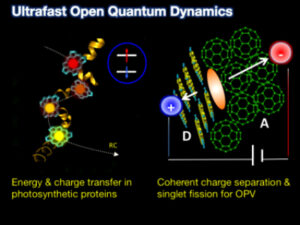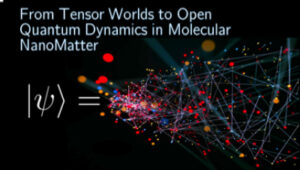List of members |
Facilities |
Internships and jobs |
PhD |
Publications |
News |
Team
- Permanent member: Alex Chin
- PhD student: Brieuc Le Dé
Quantum systems are normally characterised through the idealised behaviour of a number of active and controllable excitations such as spin, exciton, electrons, etc. However, in all real systems, these variables are unavoidably coupled to– that is to say, are open to – a much larger number of uncontrollable ‘environmental’ excitations, such as ambient phonons, or photons. These interactions lead to the emergence of irreversible quantum dynamics such as decoherence and thermalisation into quantum systems, and are strongly implicated in the transition from quantum to classical physics.
In the context of solid-state quantum technologies, such noisy and dissipative interactions generate are highly undesirable, and a microscopic understanding of open system physics is needed to mitigate deleterious environmental influences. On the other hand, nanoscale devices able to perform energy harvesting must necessarily be open to energy sources, sinks and working media, often at the level of single quantum exchanges. This is strikingly illustrated in biological proteins involved in photosynthesis, where optoelectronic properties are determined by both protein structures and the quantised dynamics of their molecular vibrations.
Our sub-team develops advanced numerical methods and analytical theories to describe the rich and ill-understood physics of open quantum systems in the conditions relevant to organic nanomaterials. Working closely with experimental experts in ultrafast spectroscopy and microscopy, we explore how fundamental system-environment processes could be engineered for novel applications, or might confess quantum advantages in tomorrow’s energy conversion materials.

Caption: Photosynthetic organisms use proteins to control molecular interactions and dissipate the energy need to guide photoexcitations to where they are dissociated into reactive charge (electron-hole) pairs. A similar process must occur in organic solar cell materials, but is often much less efficient.

Caption: In our tensor network approach to open systems, the entire system and environment wave function is represented by a network of ‘near-sighted’ interacting objects that can be efficiently stored and updated. This permits very large environments to be simulated, and highly detailed information on system-environment correlations to be extracted in real-time.
Key applications
- Theory of entangled optical excitations in 1D organic wires: from strong fermionic correlations to multiple carrier generation in next-gen solar cells.
- Design concepts for harnessing non-classical dissipative effects in molecular nano ‘machines’ for energy harvesting, catalysis and sensing.
- Understanding the links between quantum excitation transfer, efficient functionality and the multiscale spatio-temporal dynamics of optoelectronic protein structures.
Fundamental theory techniques
- Advanced Tensor Network, MPS and DMRG algorithms for simulating the non-equilibrium dynamics of many body and open quantum systems.
- Master equations and numerical path integral propagators (TEMPO) for non-Markovian dissipation (with B. Lovett, Saint Andrews).
- First-principle electronic structure and motion methods (GW, BSE, TD-DFT, molecular dynamics) for the prediction of electron-phonon interactions and excited-state properties in molecular materials (With M. Calandra and Ludger Wirtz).
Recent publications
- Optical Projection and Spatial Separation of Spin-Entangled Triplet Pairs from the S1 (21Ag–) State of Pi-Conjugated Systems Pandya et al. Chem 6 (10), 2826 (2020) https://www.sciencedirect.com/science/article/pii/S2451929420304757
- A molecular movie of ultrafast singlet fission Schnedermann et al. Nature communications 10 (1), 1 (2019) https://www.nature.com/articles/s41467-019-12220-7
- Tensor network simulation of multi-environmental open quantum dynamics via machine learning and entanglement renormalisation Schröder et al. Nature communications 10 (1), 1062 (2019) https://www.nature.com/articles/s41467-019-09039-7

